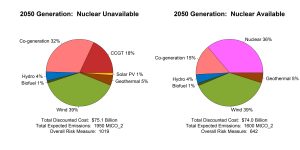Two large jurisdictions in the US are taking two very different approaches to reducing greenhouse gases: California has indicated that they will expand renewable energy capacity while simultaneously shutting down their nuclear power stations, whereas New York has announced that they will maintain their nuclear power stations and build out renewable energy on their path to low carbon electricity [1,2]. The UK has gone one step further along the nuclear path announcing the construction of a new nuclear power plant, the first in over 30 years [3]. A recent TED talk discusses the decline in nuclear capacity expected over the next few years and argues that this will cancel out any emissions reductions expected from increased installations of renewable energy [4].
In Canada, Ontario generated 60% of its electrical energy from nuclear in 2015 [5] while Alberta has no nuclear facilities and relies to a large degree on fossil fuels. Both jurisdictions are looking at expanding renewable energy to serve future demands while reducing greenhouse gas emissions. Time will tell if the nuclear-based New York approach or the non-nuclear California approach will have the best outcomes but our recent analysis of future electrical systems may provide some insights.
We examine the value of nuclear generation with regards to emission uncertainty using an optimal planning model. A fossil fuel dominated jurisdiction, similar to the current Alberta system, is modelled and system evolution is analyzed where each energy source (i.e. coal, natural gas, nuclear, geothermal, hydro, solar, biofuel, wind) has a probable range of equivalent CO2 emissions. Our study is based on a financial portfolio risk analysis to characterize the risk of increased CO2 emissions. The method allows for the quantification of both the expected level of emissions and the risk that a system will have emissions higher than expected. The risk measure is a measure of the likelihood that a given system will exceed its emissions targets, with higher numbers indicating a higher risk (details of methodology and results are described in a manuscript currently under review.).
Figure 1 shows the energy generation by different technologies in 2050 for the case where nuclear is unavailable and the case with nuclear available. The cost, expected emissions, and risk of exceeding emissions targets are shown below the figure. Briefly, we find that when nuclear is available: (1) emissions are expected to be almost 20% lower; (2) the risk, or the likelihood that we exceed this lower emissions level, is 35% lower and (3) the overall system cost is 1.5% lower than when nuclear is not available. Nuclear benefits the final system because it provides firm, reliable energy and, with modern reactor technology, it is able to follow both load and the variability of renewable generation [6–9]. It is also one of the lowest emissions technologies available for power generation which is why it reduces the emissions risk when available. Although nuclear does have a large up-front capital cost, the model suggests that including nuclear as an option results in a reduced risk of increased emissions while at the same time realizing cost savings for the system.
These results highlight one of the challenges faced by electrical system operators – the need to meet future performance targets while considering uncertainty. With carbon constraints and policies becoming a key consideration, the role of nuclear power and its value in future electrical systems is being re-examined with emissions risk in mind.
What might this mean for Alberta? Alberta is currently implementing policies to eliminate coal power and build out renewable generation [10], with no proposals for nuclear power currently in the public domain. Including nuclear in the available generation options for replacing coal may allow for this shift to low carbon generation to happen with overall lower climate impacts, a lower risk of exceeding these emissions and at a lower cost.
Emissions risk is obviously not the only factor in making energy supply decisions. Although it provides an interesting perspective on generation choices, other considerations include waste disposal for fossil and nuclear generation, decommissioning costs and impacts, water use for thermal generation plants, air quality impacts from fossil fuels, and social license in general. These considerations were not included in the current analysis.
This work was published in Energy Strategy Reviews: T. Niet et al., “Hedging the risk of increased emissions in long term energy planning,” Energy Strategy Reviews, vol. 16, pp. 1–12, Jun. 2017.
References
[1] Plumer B. Nuclear power and renewables don’t have to be enemies. New York just showed how. Vox 2016. http://www.vox.com/2016/8/2/12345572/new-york-nuclear-wind-solar (accessed September 16, 2016).
[2] Penn I, Masunaga S. PG&E to close Diablo Canyon, California’s last nuclear power plant. LA Times 2016. http://www.latimes.com/business/la-fi-diablo-canyon-nuclear-20160621-snap-story.html (accessed October 11, 2016).
[3] B. B. C. News. Hinkley Point: UK approves nuclear plant deal. BBC News 2015. http://www.bbc.com/news/business-37369786 (accessed September 16, 2016).
[4] Shellenberger M. How fear of nuclear power is hurting the environment. Banff, Alberta, Canada: 2016.
[5] Nuclear power in Canada. Wikipedia Free Encycl 2016.
[6] Cany C, Mansilla C, da Costa P, Mathonnière G, Duquesnoy T, Baschwitz A. Nuclear and intermittent renewables: Two compatible supply options? The case of the French power mix. Energy Policy 2016;95:135–46. doi:10.1016/j.enpol.2016.04.037.
[7] Kidd S. Nuclear in France–what did they get right? With its fleet of standardised, load-following nuclear reactors and range of domestic fuel cycle facilities, the French nuclear programme is certainly unique. But it is not without critics. Nucl Eng Int 2009;54:14+.
[8] Locatelli G, Boarin S, Pellegrino F, Ricotti ME. Load following with Small Modular Reactors (SMR): A real options analysis. Energy 2015;80:41–54. doi:10.1016/j.energy.2014.11.040.
[9] Lokhov A. Load-following capabilities of NPPs: the load following capability of both Russian and Western-designed pressurized waster reactors has evolved considerably since the 1980s. Nucl Eng Int 2012;57:34+.
[10] Healing D. Alberta eyes renewable energy boom with 5,000-megawatt target by 2030. Financ Post 2016. http://business.financialpost.com/news/energy/alberta-eyes-renewable-energy-boom-with-5000-megawatt-target-by-2030 (accessed September 16, 2016).
[11] Innovative Research Group. Alberta Nuclear Consultation. Alberta, Canada: Alberta Ministry of Energy; 2009.
